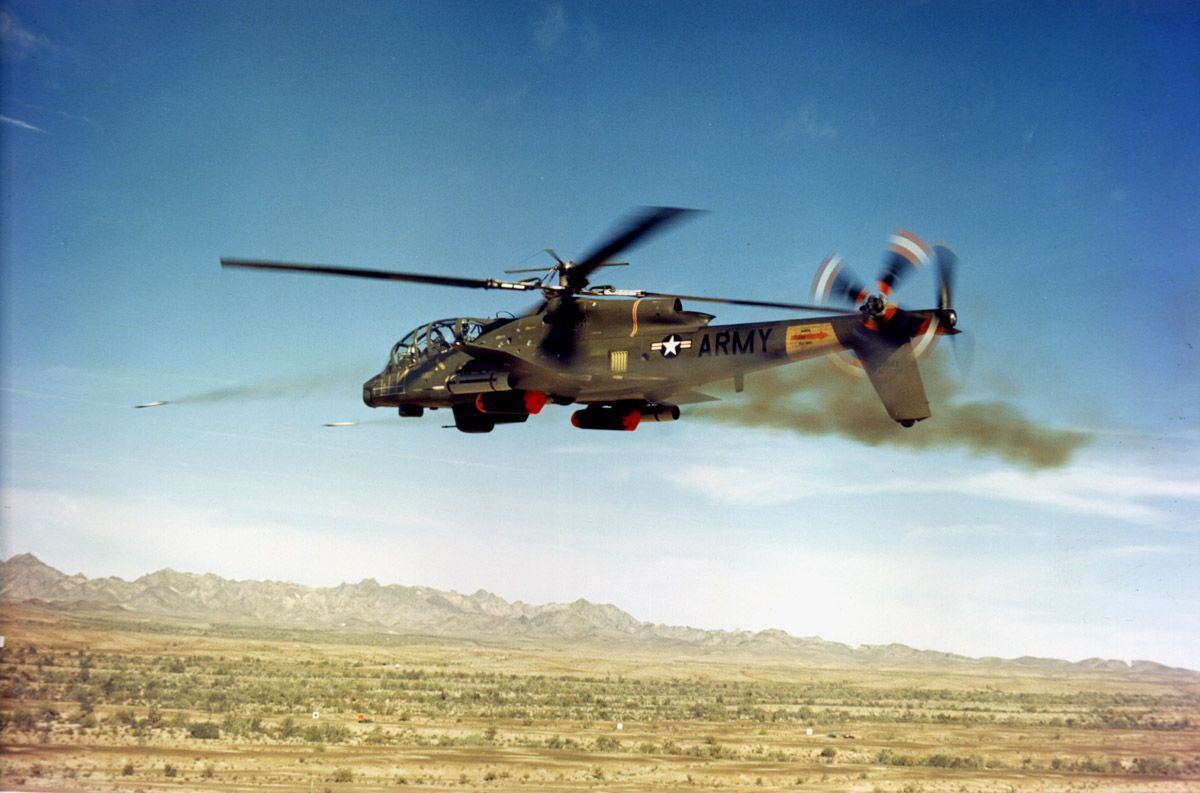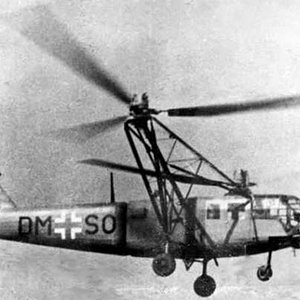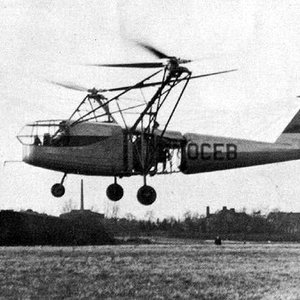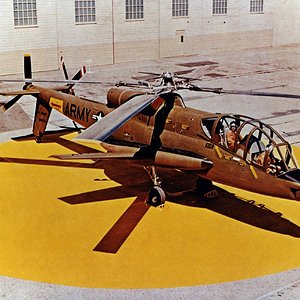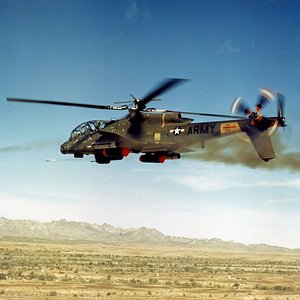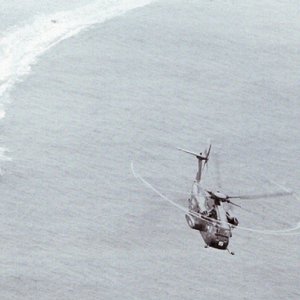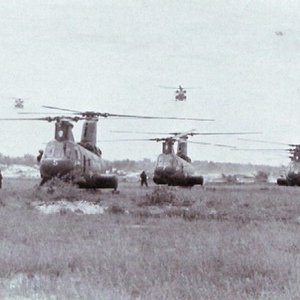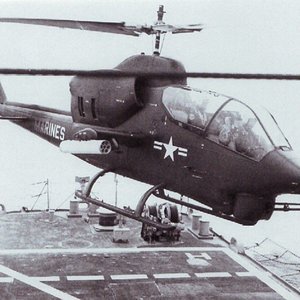Navigation
Install the app
How to install the app on iOS
Follow along with the video below to see how to install our site as a web app on your home screen.
Note: This feature may not be available in some browsers.
More options
You are using an out of date browser. It may not display this or other websites correctly.
You should upgrade or use an alternative browser.
You should upgrade or use an alternative browser.
AH-56A Cheyenne
The AH-56 Cheyenne was a prototype attack helicopter developed to replace the AH-1 Cobra. It never went into production. The Army -- in cooperation with industry -- began developing the AH-56 Cheyenne and the AH-64 Apache during the final years of the Vietnam conflict. The Army's development of specifically designed attack helicopters during the 1970s again raised the question of Army and Air Force aerial missions. By this time, the Air Force was content to permit the Army to continue developing helicopters.
The experience of Vietnam showed that the existing attack helicopter, the AH-1 Cobra, was vulnerable even to light antiaircraft fire and lacked the agility to fly close to the ground for long periods of time. The AH-56A Cheyenne helicopter was intended to correct those deficiencies.
The Lockheed AH-56A Cheyenne attack helicopter was designed to meet the U.S. Army's requirement for the Advance Aerial Fire Support System (AAFSS). The helicopter's mission would eventually be assumed by the Boeing (formerly McDonnell Douglas) AH-64 Series Apache attack helicopter. The AAFSS, which began in 1964, was won by the Lockheed AH-56A Cheyenne. Bell entered a scaled-down version of it's Iroquois Warrior. The other competitor was the Sikorsky (S-66) (1964) which looked similar to the AH-56A Cheyenne, but had a Rotorprop tail rotor which could rotate on it's axis throught 90° to act both as an anti-torque rotor or as a pusher, thereby transforming the S-66 into a compound aircraft in cruising flight.
The AH-56 was essentially a flying tank built around rigid rotor system. This remarkable compound helicopter relied on a pusher propeller and a set of wings to achieve speeds greater than 322 kph (200 mph). The rigid-rotor Cheyenne, with a crew of two, featured a XM112 swiveling gunner's station linked to rotating belly and nose turrets, and a laser range-finder tied to a fire control computer. It was armed with an XM52 30mm automatic gun in the belly turret and a XM51 40mm grenade launcher or a XM53 7.62mm Gatling machine gun in the chin-turret, TOWs, and XM200 2.75 inch rocket launchers. The Cheyenne had a single rigid four-bladed main rotor and anti-torque tail rotor, and a three-bladed pusher. The Cheyenne was powered by one General Electric T64-GE-16 3435 shp turbine engine. The AH-56A had a maximum speed of 214 knots, cruise speed of 197 knots, a service ceiling of 26,000 feet, maximum range of 547 nautical miles, and could climb 3,420 feet per minute.
Lockheed rolled-out the first prototype on May 3, 1967. Because of the advanced technologies in the AH-56 Cheyenne, the program ran into serious delays and cost overruns. Unfortunately, the Cheyenne experienced developmental difficulties with some of the new technology it employed. Thus, Congress was severely critical of the program. However, advocates of the AH-56 Cheyenne argued that the program was about to succeed, but it would still take several years for this aircraft actually to go into the field and help soldiers on the ground. Eventually, Lockheed had eliminated nearly all of the bugs but the Cheyenne languished under an awkward procurement process put in place by Secretary of Defense Robert McNamara.
By the time the aircraft was ready for production in 1972, the Army was becoming interested in a helicopter with night and all-weather attack capability - a requirement that was not included in the Cheyenne contract. Congress then cancelled the program at a significant financial loss to Lockheed. Ten prototypes were completed before the program was terminated August 9, 1972 due to delayed development, rising costs, and the appearance of two competitive company-funded initiatives by Sikorsky and Bell. Most Cheyenne airframes ended up at Aberdeen Proving Grounds.
The Army wanted a smaller, more agile Advanced Attack Helicopter (AAH) with a less complicated fire control and navigation system. The new attack helicopter program announced in August 1972 drew from the combat experience of the Cobra and the developmental experience of the Cheyenne to specify an aircraft that could absorb battle damage and had the power for rapid movement and heavy loads. The helicopter would have to be able to fly nap of the earth and maneuver with great agility to succeed in a new antitank mission on a high-intensity battlefield. In December 1976 the Army selected the Hughes YAM-64 for production.
The AH-56 Cheyenne was a prototype attack helicopter developed to replace the AH-1 Cobra. It never went into production. The Army -- in cooperation with industry -- began developing the AH-56 Cheyenne and the AH-64 Apache during the final years of the Vietnam conflict. The Army's development of specifically designed attack helicopters during the 1970s again raised the question of Army and Air Force aerial missions. By this time, the Air Force was content to permit the Army to continue developing helicopters.
The experience of Vietnam showed that the existing attack helicopter, the AH-1 Cobra, was vulnerable even to light antiaircraft fire and lacked the agility to fly close to the ground for long periods of time. The AH-56A Cheyenne helicopter was intended to correct those deficiencies.
The Lockheed AH-56A Cheyenne attack helicopter was designed to meet the U.S. Army's requirement for the Advance Aerial Fire Support System (AAFSS). The helicopter's mission would eventually be assumed by the Boeing (formerly McDonnell Douglas) AH-64 Series Apache attack helicopter. The AAFSS, which began in 1964, was won by the Lockheed AH-56A Cheyenne. Bell entered a scaled-down version of it's Iroquois Warrior. The other competitor was the Sikorsky (S-66) (1964) which looked similar to the AH-56A Cheyenne, but had a Rotorprop tail rotor which could rotate on it's axis throught 90° to act both as an anti-torque rotor or as a pusher, thereby transforming the S-66 into a compound aircraft in cruising flight.
The AH-56 was essentially a flying tank built around rigid rotor system. This remarkable compound helicopter relied on a pusher propeller and a set of wings to achieve speeds greater than 322 kph (200 mph). The rigid-rotor Cheyenne, with a crew of two, featured a XM112 swiveling gunner's station linked to rotating belly and nose turrets, and a laser range-finder tied to a fire control computer. It was armed with an XM52 30mm automatic gun in the belly turret and a XM51 40mm grenade launcher or a XM53 7.62mm Gatling machine gun in the chin-turret, TOWs, and XM200 2.75 inch rocket launchers. The Cheyenne had a single rigid four-bladed main rotor and anti-torque tail rotor, and a three-bladed pusher. The Cheyenne was powered by one General Electric T64-GE-16 3435 shp turbine engine. The AH-56A had a maximum speed of 214 knots, cruise speed of 197 knots, a service ceiling of 26,000 feet, maximum range of 547 nautical miles, and could climb 3,420 feet per minute.
Lockheed rolled-out the first prototype on May 3, 1967. Because of the advanced technologies in the AH-56 Cheyenne, the program ran into serious delays and cost overruns. Unfortunately, the Cheyenne experienced developmental difficulties with some of the new technology it employed. Thus, Congress was severely critical of the program. However, advocates of the AH-56 Cheyenne argued that the program was about to succeed, but it would still take several years for this aircraft actually to go into the field and help soldiers on the ground. Eventually, Lockheed had eliminated nearly all of the bugs but the Cheyenne languished under an awkward procurement process put in place by Secretary of Defense Robert McNamara.
By the time the aircraft was ready for production in 1972, the Army was becoming interested in a helicopter with night and all-weather attack capability - a requirement that was not included in the Cheyenne contract. Congress then cancelled the program at a significant financial loss to Lockheed. Ten prototypes were completed before the program was terminated August 9, 1972 due to delayed development, rising costs, and the appearance of two competitive company-funded initiatives by Sikorsky and Bell. Most Cheyenne airframes ended up at Aberdeen Proving Grounds.
The Army wanted a smaller, more agile Advanced Attack Helicopter (AAH) with a less complicated fire control and navigation system. The new attack helicopter program announced in August 1972 drew from the combat experience of the Cobra and the developmental experience of the Cheyenne to specify an aircraft that could absorb battle damage and had the power for rapid movement and heavy loads. The helicopter would have to be able to fly nap of the earth and maneuver with great agility to succeed in a new antitank mission on a high-intensity battlefield. In December 1976 the Army selected the Hughes YAM-64 for production.

